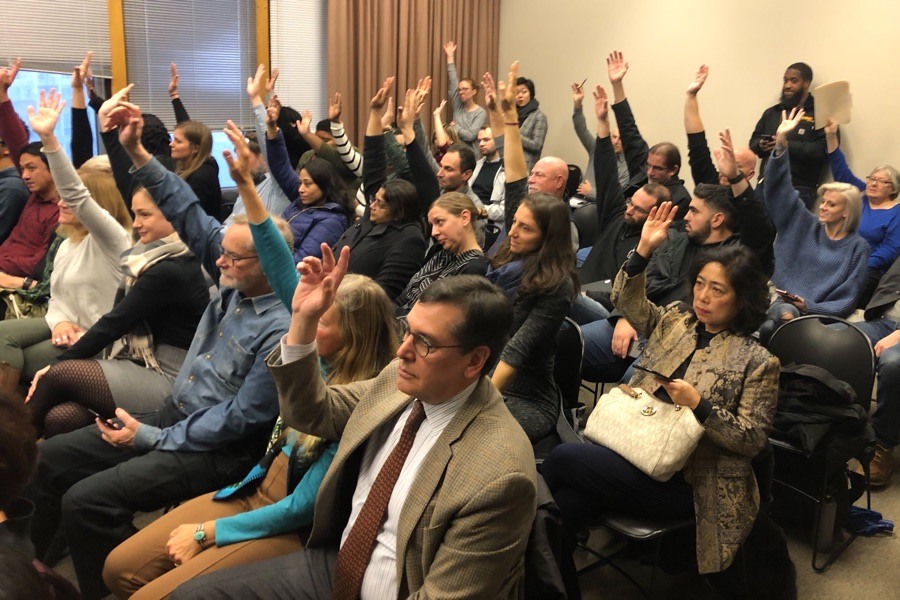A Wawa Gas Station on Columbus Boulevard? No Way, Neighbors Say. But a Regular Wawa? Sure!
A zoning hearing on a contentious proposal from developer Bart Blatstein turned into a tale of two Wawas.

All those not in favor of Bart Blatstein’s Wawa gas station. Photo by David Murrell.
If you’ve been following Bart Blatstein’s proposed Wawa gas station along Columbus Boulevard in South Philly, you know that a big chunk of the neighborhood hates the idea. So at a meeting on Tuesday morning before the Zoning Board of Adjustment, which will ultimately decide if the project is allowed to proceed, we figured things might get a little contentious between the residents and the developer.
And then a lawyer for the city — who was arguing that the gas station project shouldn’t continue — said this to the assembled board: “Let’s just stipulate: Nobody has any issue with Wawa.”
Zoning board chair Frank DiCicco smirked. “We get it,” he said. “Drop the gas stations, and we’ll be out of here in five minutes.” Upon which 90 percent of the assembled people in the room — nearly all of whom oppose Blatstein’s Wawa project — began applauding.
It seemed a confusing response. And then it dawned on us: Not all Wawas are created equal. It’s not that Pennsport residents hate the idea of a brand-new Wawa along Columbus Boulevard. (How could they? This is Philadelphia!) The neighborhood simply doesn’t want their Gobblers served with a side of gasoline.
So did the disagreement suddenly evaporate ? Not exactly. Blatstein appears to still want the gas station component, and so the meeting continued well beyond five additional minutes.
The question at issue is whether Blatstein does in fact have the right to build this “beautiful new Wawa retail store,” as his attorney put it during testimony. The nonprofit Delaware River Waterfront Corporation, which helped the city develop a master plan for the waterfront replete with riverside parks and pedestrian walkways, argues Blatstein doesn’t. The DRWC has cited City Council–approved zoning laws that say gas stations aren’t allowed on so-called “river access streets,” of which Columbus Boulevard is one.
But Blatstein found a way around that law, with a bit of mapmaking trickery that would have made Mercator proud. He essentially created a new, subdivided plot of land — separate from the Wawa plot — which abuts Columbus Boulevard. That means he can now say his proposed gas station is actually located on neighboring Tasker Street, which wasn’t subject to that “river access street” prohibition at the time he applied for his permit. (Another added wrinkle: Tasker is now also a river access street, and the DRWC claims that Blatstein sent in new paperwork just a few days before that new rule went into effect.)
The city’s Licenses & Inspections department recently approved Blatstein’s subdivision. That means he’s not technically breaking the zoning code, and therefore doesn’t have to apply for a variance. Instead, he just needs the zoning board to approve what’s called a “special exception” for his gas pumps. That’s a considerably easier bar to clear than a variance.
The DRWC, though, isn’t accepting the L&I ruling and is appealing the decision before the zoning board. “It’s a charade,” DRWC president Joe Forkin says of Blatstein’s subdividing maneuvers. (Blatstein declined to comment for this story.)
Now, you might expect an urbanist like Forkin, who dreams of a much glitzier waterfront revival along the Delaware, to also reject outright the idea of a regular, non-gas-station Wawa. But he doesn’t go that far. “Retail is not bad,” he says, sounding like someone who doesn’t love the idea of yet another Wawa but who also knows it’s not a hill worth dying on. “If a building creates a commercial amenity in which the neighborhood could get something eat, that’s fine.” The problem, he reiterates, is really the gas station, which he believes brings with it all sorts of traffic that isn’t conducive to a walkable urban space.
But Forkin, who was scheduled to testify alongside Blatstein, didn’t get the chance to say much of that on Tuesday, as the meeting ran over its allotted time shortly into his testimony and was continued to January. Still, before the proceedings concluded, zoning chairman DiCicco asked how many in the room opposed Blatstein’s project. Ninety percent of the hands in the conference room shot up.
Then he asked who supported the plan. Blatstein and a few others meekly raised their hands.
In other words, the fault lines are still there. But one is now left to wonder: What would the show of hands look like if Blatstein dropped the gas but kept the Wawa?


